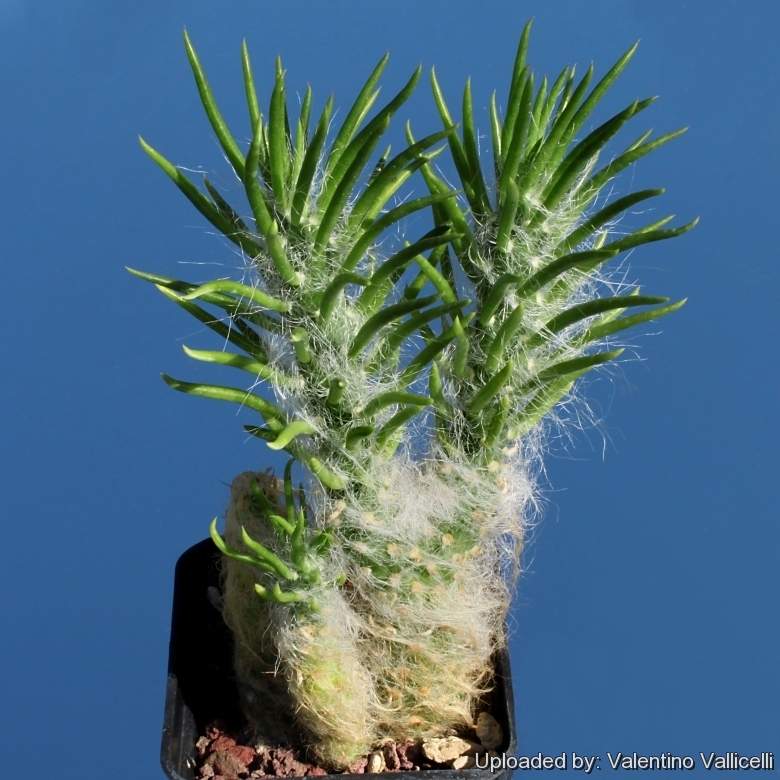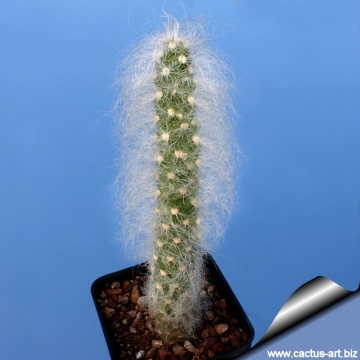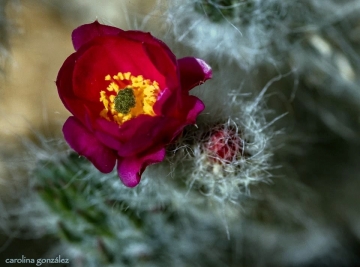Accepted Scientific Name: Austrocylindropuntia vestita (Salm-Dyck) Backeb.
Cactaceae (Berlin)

Opuntia heteromorpha (Austrocylindropuntia vestita) Photo by: Valentino Vallicelli
Origin and Habitat: Austrocylindropuntia vestitaSN|4067]]SN|4067]] occurs in Argentina in Jujuy and Salta, and in Bolivia in Cochabamba, Chuquisaca, La Paz, Potosi and Tarija.
Altitude range: 2,400 and 3,600 metres above sea level.
Habitat and Ecology: The species grows in high altitude grasslands on rocky soils. There are no major threats for this species. Austrocylindropuntia vestitaSN|4067]]SN|4067]] is is widespread and abundant, and there are no major threats.
Synonyms:
See all synonyms of Austrocylindropuntia vestita
Common Names include:
ENGLISH: Old Man Opuntia, Cotton Pole, Cotton Coral Cactus
Description: Austrocylindropuntia vestitaSN|4151]]SN|4067]] is usually a slender columnar white and very furry cactus from high altitude. The standard plants form branch both basally and near the top of the stems.
Derivation of specific name. The species name "vestita" refers to the plants' vestments, its clothing of white hairs that turns into dens colonies what appears to be patches of snow remembering the high mountain peaks that surround - on all sides - the habitat of this plant.
Stems: Cylindrical 2-3 cm in diameter covered densely with long white hairs. The stems can eventually grow to almost 60 cm tall.
Leaves: Thin subulate, caducous (but lasting from spring to autumn if the plant is kept regularly watered)
Spines: Few thin, up to 1 cm long and white. The plant has also abundant long, fine and rubbery hairs which completely cover the branches.
Flowers: A. vestita is not a reliable bloomer. When flowering finally occurs, the flowers will be a beautiful deep red or violet up to 2-2,5cm . The hairiness of the pericarpel is mostly as dense as that of the stems, merely the spination remains less. The flowers are developed always at the top of the stems.
Related species: A. vestita is closely related to Austrocylindropuntia shaferiSN|4067]]SN|4151]] but more cespitose, shorter and smaller, and with sterile fruit. Moreover the stems of A. vestita are completely covered with hairs with spines less than 15 mm long, while the stems of A. shaferi have some hairs only on the juvenile growth and spines 10-50 mm long.
Subspecies, varieties, forms and cultivars of plants belonging to the Austrocylindropuntia shaferi / vestita group
 Austrocylindropuntia shaferi (Britton & Rose) Backeb.: (var. shaferi) has some hairs on the juvenile growth only; spines up to 15, 10-50 mm long, usually reddish. Distribution: Argentina in Jujuy, and in Bolivia in Chuquisaca, Oruro, Potosí and Tarija.
Austrocylindropuntia shaferi (Britton & Rose) Backeb.: (var. shaferi) has some hairs on the juvenile growth only; spines up to 15, 10-50 mm long, usually reddish. Distribution: Argentina in Jujuy, and in Bolivia in Chuquisaca, Oruro, Potosí and Tarija.- Austrocylindropuntia shaferi var. humahuacana (Backeb.) R.Kiesling: has few, weak spines, up to 1 cm., usually whitish. Distribution: Humahuaca, Jujuy, Argentina.
 Austrocylindropuntia vestita (Salm-Dyck) Backeb.: has steins completely covered with hairs; spines less than 15 mm long. Distribution: Argentina (Jujuy and Salta), and Bolivia (Cochabamba, Chuquisaca, La Paz, Potosi and Tarija).
Austrocylindropuntia vestita (Salm-Dyck) Backeb.: has steins completely covered with hairs; spines less than 15 mm long. Distribution: Argentina (Jujuy and Salta), and Bolivia (Cochabamba, Chuquisaca, La Paz, Potosi and Tarija). Austrocylindropuntia vestita f. cristata: crested form.
Austrocylindropuntia vestita f. cristata: crested form.- Austrocylindropuntia weingartiana (Backeb.) Backeb.: A. weingartiana and A. shaferi are one and the same species.
Notes: The genus Austrocylindropuntia comprises eleven species and was created by Curt Backeberg in 1938 for the cylindrical Opuntias of South-America. The cylindrical Opuntias of North-America was instead placed in the genus Cylindropuntia. Austrocylindropuntia can easily be distinguished from Cylindropuntia: Cylindropuntia spines have papery sheaths, Austrocylindropuntia spines lack them. Austrocylindropuntia have cylindrical stems that grow indeterminately, not like many other Opuntias with stems that grow in a single season. Fresh stems have noticeable leaves that soon fall off. Austrocylindropuntias form low cushions or bushes up to 3 of 5m. The seeds are different too.
Bibliography: Major references and further lectures
1) Roberto Kiesling “The identity of Austrocylindropuntia weingartiana” The Cactus and Succulent Journal of Great Britain Volume 42(4): 109 -no (1980)
2) Kiesling, R., Lowry, M. & Ortega-Baes, P. 2013. Austrocylindropuntia vestita. The IUCN Red List of Threatened Species 2013: e.T152406A633352. http://dx.doi.org/10.2305/IUCN.UK.2013-1.RLTS.T152406A633352.en. Downloaded on 13 March 2016.
3) N. L. Britton, J. N. Rose: “The Cactaceae. Descriptions and Illustrations of Plants of the Cactus Family.” Vol I, The Carnegie Institution of Washington, Washington 1919
4) David Hunt, Nigel Taylor “The New Cactus Lexicon” DH Books, 2006
5) Edward F. Anderson “The Cactus Family” Timber Press, 2001Hunt, D., Taylor, N. and Charles, G. (compilers and editors). 2006. The New Cactus Lexicon. dh Books, Milborne Port, UK.
 Opuntia heteromorpha (Austrocylindropuntia vestita) Photo by: Cactus Art
Opuntia heteromorpha (Austrocylindropuntia vestita) Photo by: Cactus Art Opuntia heteromorpha (Austrocylindropuntia vestita) Photo by: Carolina González
Opuntia heteromorpha (Austrocylindropuntia vestita) Photo by: Carolina González Opuntia heteromorpha (Austrocylindropuntia vestita) Photo by: Valentino Vallicelli
Opuntia heteromorpha (Austrocylindropuntia vestita) Photo by: Valentino VallicelliSend a photo of this plant.The gallery now contains thousands of pictures, however it is possible to do even more. We are, of course, seeking photos of species not yet shown in the gallery but not only that, we are also looking for better pictures than those already present.
Read More... Cultivation and Propagation: This particular species needs regular watering when soil is dry during the growing seasonis but it is prone to root rot, so prudent watering is necessary. Keep dry in winter. I comes from high altitude and do not like hot, stuffy summers, it is best to put them in airy places with ample airflow. It requires a very drained and mineral potting mix and a full sun or slightly shady exposure. Protect from severe frost.
Propagation: Seeds are seldom available and extremely difficult to germinate. Best reproduced by cutting that produce roots easily. The crested variety, which is more delicate, multiplies more easily using grafting.













